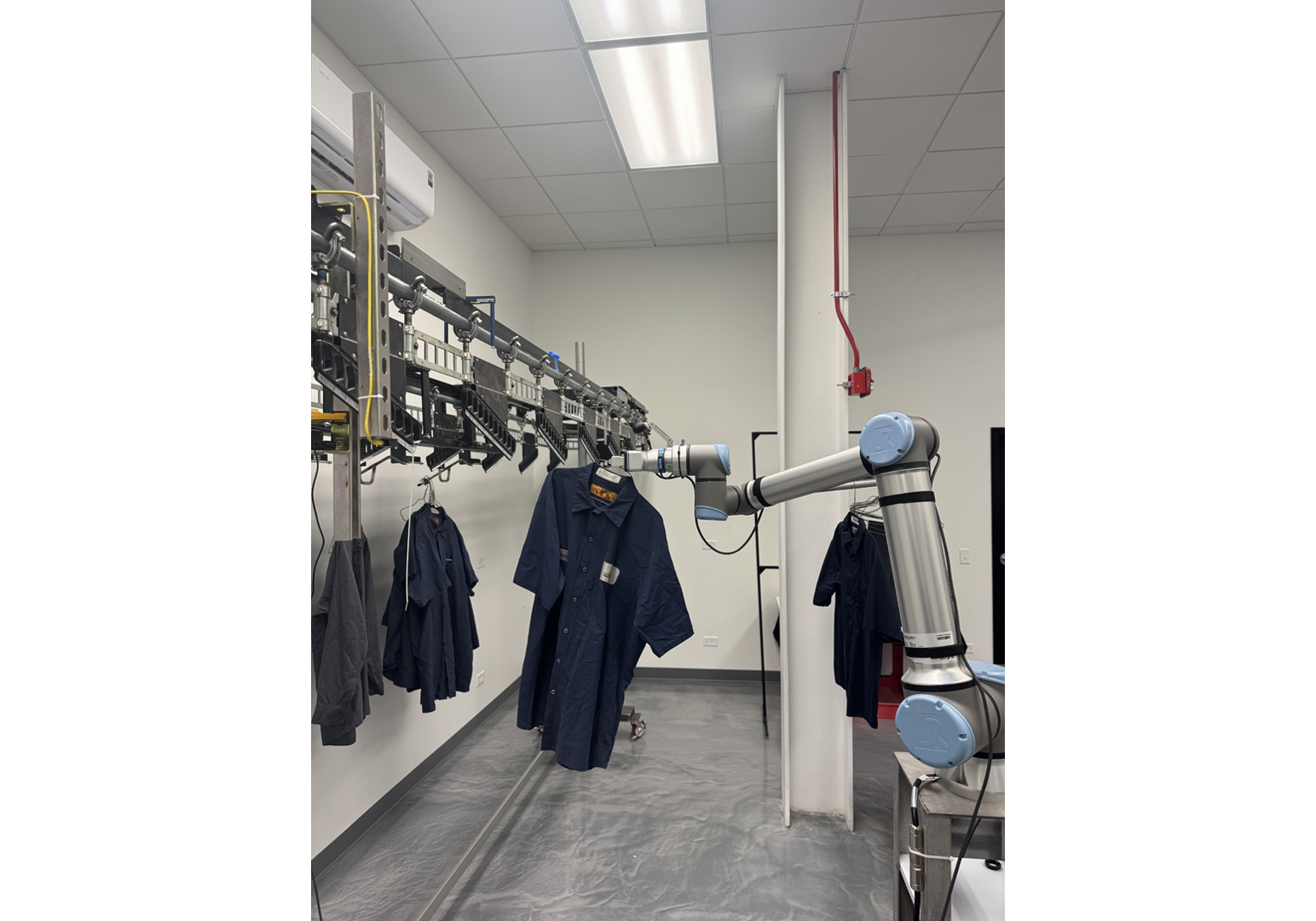Many laundries today face significant labor shortages. Common issues include high turnover and fierce competition for staff that’s driving up wage and administrative costs. Now, robotics – fueled by open-source software and advances in artificial intelligence (AI) – could help fill the gap with cost-effective collaborative robots (aka cobots) that can place shirts on sortation systems and feed flatwork.
While laundry robotics generally has advanced further in Europe than the U.S., TRSA supplier partner Spindle has taken a pioneering role in cobot development. Working in collaboration with Universal Robots, a global leader in robotic automation, they are seeking to craft a solution for finishing-side labor shortages. Universal Robots, with a U.S. headquarters outside Detroit, has 100,000 cobots working in industrial settings worldwide, according to Tom Abbett, Spindle’s director of strategic initiatives.
Textile Services Weekly recently interviewed both Abbett and Spindle CEO Chris Dobrez, on where they see this technology headed. We began by asking Dobrez how significant the potential is to save labor in commercial laundries by deploying cobots. “The potential labor savings are tremendous,” he said. “During our automation-opportunity research we identified several areas where cobots or other automation innovations can have a significant impact in reducing FTEs (full-time employees) in a laundry facility. We vetted our research with a variety of cobot, robot and general-automation companies to identify where we could have the biggest impact, the soonest.”
The process began by looking at ways to automate napkin feeding, he said. “We know this is a long-sought solution for the industry,” he said. “It has been technically non-feasible for a long time, primarily due to the fact that robot technology has not yet developed the ability to handle ‘deformable’ objects (e.g., napkins). But robot technology has advanced significantly in just the last couple of years.” Another area of progress is the development of computer-based “vision” using cameras, coupled with AI-assisted programming and simulation training. “Robotic technology for deformable objects is coming, but we need more breakthroughs in the field of ‘physical intelligence,’ an offshoot of artificial intelligence,” Dobrez said. “We decided to pivot and focus our development on garment sort. There is a significant opportunity, and it is technically feasible to replace FTEs that currently sort garments in facilities.”
Abbett attributes this recent progress in laundry automation to several factors including 1) the “democratization” of robots 2) advances in AI and 3) an expanded focus on cobots, vs. industrial robots like those used in auto manufacturing. Robotic systems require safety fencing to protect employees from moving arms, etc. Cobots are smaller and more versatile, he said. Operators can program them to stop automatically if an employee steps in the way of their movements, such as when they’re placing shirts on a numbered sorting hook in a finishing operation.
As for democratization, “Historically, the cost and complexity of building robotics in our industry didn’t align with the economics that made sense for our end customers,” Abbett said. “As a result, robotics remained out of reach for most. Now, with advancements in technology and more affordable, accessible robots, Spindle has developed a robotics solution where the ROI finally works. By lowering barriers to implementation, we’re making robotics a practical, scalable solution for the commercial laundry industry.”
Concurrently, video technology has advanced to where cameras can observe an employee doing a task such as placing a hanger on a sorting hook. “It knows the speed of the conveyor,” Abbett said. “It knows where the hooks are because it’s got ‘vision.’ It also has AI (click here to see a demo).”
Developing laundry robotics still has a long way to go, he cautioned, but Spindle now has a full team of robotic engineers and accompanying technical experts to drive the project forward. Abbett has pulled in other vendors, like conveyor and overhead rail providers, that are contributing to the successful creation of a new class of Robotic Garment Conveyors to move the laundry industry into leaner operations.
Dobrez said that in order to make cobots a practical solution for laundries, Spindle needed a robotics collaborator that saw the potential for advancing automation in textile services. After an extensive search, they found one in Universal Robotics. “We ended up collaborating with Universal Robots (Teradyne Robotics, a division of this microchip-testing company) as they are the leader in cobot technology,” he said. “Together we have been working on a solution to replace FTEs that handle various garment-sort activities in a laundry operation.” Along with labor savings, Dobrez noted that, “Our internal ROI calculations so far are extremely encouraging.”
Watch for more in April’s Textile Services magazine and at the Aug. 23-26 Clean Show in Orlando.
Publish Date
February 28, 2025
Categories
Sign Up For Our Newsletter
Receive the latest updates on the linen, uniform and facility services industry from TRSA delivered straight to your inbox.








